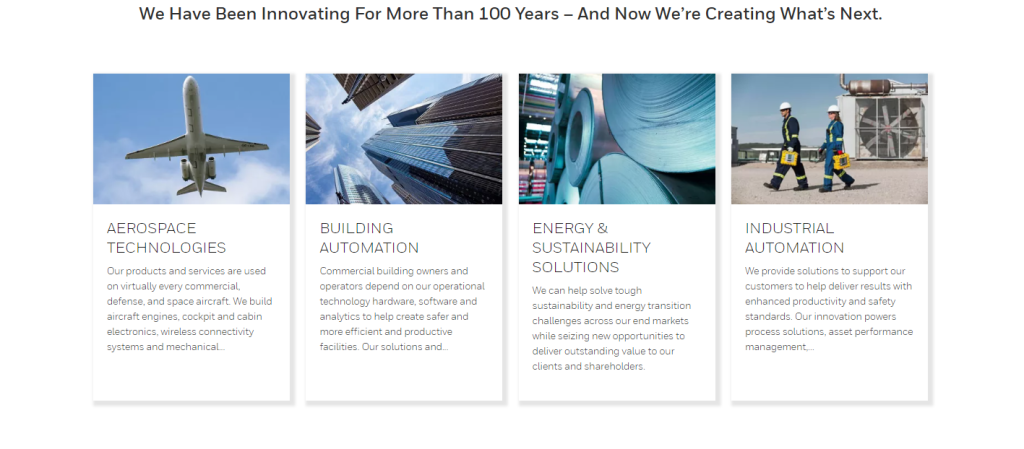Table of Contents
ToggleA Brief History of Honeywell
Honeywell International Inc. is a multinational conglomerate that operates in a variety of industries, including aerospace, building technologies, performance materials and technologies, and safety and productivity solutions. The company has a long and storied history that dates back to 1906 when it was founded as the Honeywell Heating Specialty Company by Mark C. Honeywell.
Initially, the company focused on thermostats and heating systems, but it quickly expanded into other areas, such as automotive products and aviation technology. In the 1920s, Honeywell began producing a wide range of consumer products, including air conditioning systems and automobile parts.
During World War II, Honeywell played a crucial role in the war effort, producing a variety of military equipment and technology. After the war, the company continued to expand and diversify, acquiring a number of other companies and establishing itself as a major player in the aerospace and defense industries. In the 1980s, Honeywell further expanded its reach by acquiring several other companies, including Sperry Corporation and Bull Inc.
In 1999, Honeywell was acquired by AlliedSignal Inc., and the combined company was renamed Honeywell International Inc. Since then, Honeywell has continued to grow and innovate, developing new technologies and expanding its global presence. Today, the company is a leading provider of aerospace products and services, building technologies, and safety and productivity solutions, with operations in over 70 countries.
Who Owns Honeywell?
Honeywell International Inc. is a global conglomerate that specializes in diversified technologies and manufacturing. As a publicly-traded company, Honeywell has a wide range of shareholders who collectively own the company. The top 10 shareholders of Honeywell International Inc. are as follows:
1. The Vanguard Group, Inc.
2. BlackRock, Inc.
3. State Street Corporation
4. Capital Research Global Investors
5. Massachusetts Financial Services Co.
6. T. Rowe Price Associates, Inc.
7. Northern Trust Corporation
8. Wellington Management Company, LLP
9. Bank of America Corporation
10. Geode Capital Management, LLC
These shareholders represent a mix of institutional investors, mutual funds, and individual investors who have a significant stake in the company. The diverse ownership structure of Honeywell International Inc. reflects the company’s global reach and appeal to a wide range of investors.
Honeywell Mission Statement

Honeywell International Inc.’s mission is to deliver industry-leading technologies and solutions that develop and sustain a safe, comfortable, and efficient environment for people to live and work. They strive to provide innovative and reliable products that meet the changing needs of their customers while also promoting sustainability and environmental responsibility. Honeywell is committed to delivering quality and value to their customers, shareholders, and employees while maintaining a culture of integrity, diversity, and inclusion.
How Honeywell Makes Money?
Honeywell International Inc. operates under a diversified business model, generating revenue through a combination of product sales, service contracts, and technology licensing. The company’s primary revenue streams come from the sales of advanced aerospace systems, home automation and security products, industrial equipment, and performance materials. Honeywell also earns income from long-term service contracts for maintenance and support of its products, as well as through licensing agreements for its innovative technologies. This multi-faceted approach allows Honeywell to generate significant revenue across its various business segments, making it a leader in the global industrial and technology markets.
Honeywell Business Model Canvas
The Business Model Canvas is a strategic management tool that provides a visual representation of an organization’s business model. It allows businesses to identify key components of their operations, including customer segments, value propositions, channels, customer relationships, revenue streams, key resources, key activities, key partners, and cost structure. This framework is especially useful for analyzing and developing business strategies, as it provides a comprehensive overview of how a company creates, delivers, and captures value.
Customer Segments:
1. Commercial and Industrial Customers
2. Government and Defense Clients
3. Residential Consumers
4. Aerospace and Automotive Industries
Value Propositions:
1. Innovative Technology Solutions
2. Reliable and Quality Products
3. Exceptional Customer Service
4. Industry Expertise and Experience
Channels:
1. Direct Sales and Marketing
2. Distribution Partnerships
3. E-commerce Platforms
4. Service and Maintenance Contracts
Customer Relationships:
1. Personalized Support and Consultation
2. Ongoing Training and Education
3. Customer Feedback and Engagement
4. Technical Support and Assistance
Revenue Streams:
1. Product Sales
2. Service and Maintenance Contracts
3. Licensing and Royalties
4. Subscription Fees
Key Resources:
1. Research and Development Facilities
2. Manufacturing Plants and Equipment
3. Skilled Workforce
4. Intellectual Property Rights
Key Activities:
1. Research and Development
2. Product Manufacturing
3. Sales and Marketing
4. Customer Support and Maintenance
Key Partners:
1. Suppliers and Manufacturers
2. Distribution and Channel Partners
3. Technology and Innovation Partners
4. Government and Defense Contracts
Cost Structure:
1. Research and Development Expenses
2. Manufacturing and Production Costs
3. Sales and Marketing Expenses
4. Operational and Administrative Overhead
Honeywell’s Competitors
Honeywell International Inc. operates as a diversified technology and manufacturing company, providing aerospace products, control technologies for buildings, homes and industry, turbochargers, automotive products, specialty chemicals, electronic and advanced materials, and process technology for refining and petrochemicals. Its top 5 competitors include:
1. General Electric Company
2. Siemens AG
3. United Technologies Corporation
4. Emerson Electric Co.
5. Rockwell Automation, Inc.
Honeywell SWOT Analysis
Strengths:
1. Strong brand reputation and global presence
2. Diverse portfolio of products and services in aerospace, building technologies, and performance materials
3. Robust research and development capabilities
4. Strong financial performance and stability
Weaknesses:
1. Vulnerability to economic downturns due to dependence on industrial and commercial markets
2. Limited presence in consumer-facing markets
3. Slow adoption of new technologies in some areas
Opportunities:
1. Expansion into emerging markets
2. Increasing demand for smart and connected technologies in buildings and industries
3. Growing focus on sustainability and energy efficiency
Threats:
1. Intense competition in the aerospace and building technologies industries
2. Economic uncertainty and geopolitical tensions impacting global markets
3. Technological obsolescence in rapidly advancing industries, such as aerospace and industrial automation.
Concluding Analysis
As I reflect on the business model of Honeywell International Inc., I am impressed by its diversity and innovation in the various sectors it operates in. The company’s ability to continually adapt to market demands and technological advancements gives me great optimism for its future success. With a strong portfolio of products and services, and a commitment to sustainability and growth, I believe that Honeywell International Inc. is well-positioned to thrive in the years to come. As an analyst, I am confident that the company will continue to lead in its respective industries and deliver value to its shareholders.
Additional Resources
To keep learning and advancing your career, we highly recommend these additional resources:
Business Model Canvas of The Top 1,000 Largest Companies by Market Cap in 2024
A List of 1000 Venture Capital Firms & Investors with LinkedIn Profiles
Peter Thiel and the 16 Unicorns: The Legacy of Thiel Fellowship












